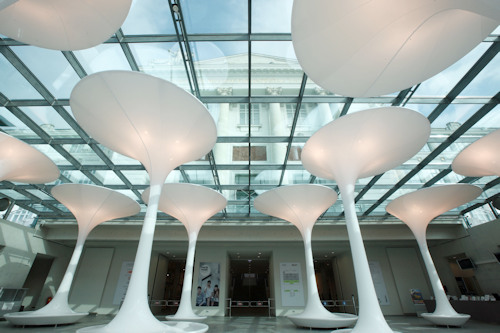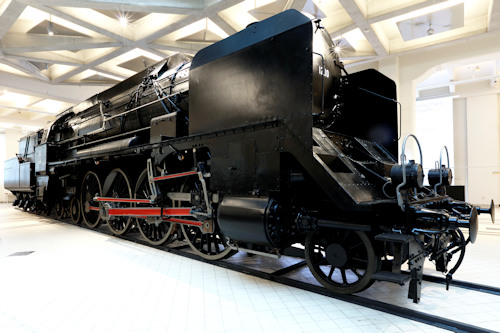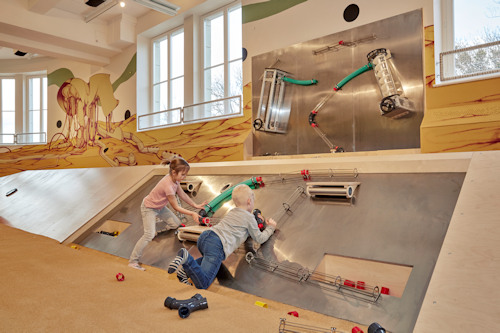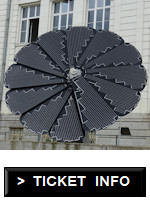Walking around the Technisches Museum (Museum of Science & Technology) is quite overwhelming. So much to see. So much to do. Almost too much for one trip, frankly.
- Contains numerous interactive stations and experiences
- Lots of big machines, such as locomotives, planes and industrial equipment
- All tied together in themed displays
- Soft play areas for young children, too
- See also:
What’s inside?

(Steam engine gallery with multimedia show; press photo © Technisches Museum Wien)
The answer is “lots”. Which is the problem.
On arrival, I suggest you browse the museum map provided and pick those areas of greatest appeal to you.
Below is my entirely subjective selection of highlights influenced by the little boy inside me who likes to press buttons and gawp at planes.
And these few highlights cannot begin to express the wealth of exhibits in the Technisches Museum.
The themed areas contain heaps of information, too. If you want to fully explore a topic, you need to take quite a bit of time to go through the exhibits, read the display information, and try out the interactive experiences.
Alternatively, you can just run through the museum and point at the big trains. Whahay!
(The museum adds new sections all the time, so be prepared for additions. Not to mention the special temporary science exhibitions.)
Floor 1

(Entrance hall of the museum; press photo © Technisches Museum Wien)
You might rename this the “hands-on” floor, since both halves offer ample opportunity for interactive learning.
The In Motion section explores various aspects of movement, both physical and mechanical. So you might, for example…
- Try a wheelchair simulator to better grasp the challenges faced by users
- Compare the weight and inner workings of two car doors or two bicycle frames separated by years of further technical development
- Use the 3D speed simulator to understand how the brain copes as external information appears at an ever greater rate
- Experience the difference between road and rail by pulling truck and train wheels
The Nature & Knowledge section is closed for redevelopment at the time of writing, but tackles natural scientific phenomenon, combining a trip through history with interactive illustrations of such principles as magnetism or space curvature.
It feels a little like wandering through Frankenstein’s laboratory with all the brass, copper, and coils of the instruments and machinery. Close your eyes and imagine a scientist with no eyebrows muttering, “more power, Igor, more power”.
A fair few glorious historical treasures nestle among the display cabinets. For example:
- A reflecting telescope from William Herschel (who more or less discovered the planet Uranus)
- A 16th-century astronomic “Prunkuhr”, a heavily decorated clock mechanism for predicting astrological events and similar. (The earth is still at the centre of everything.)
Floor 2

(The 12.10 steam locomotive; press photo © Technisches Museum Wien)
This floor traces the development of particular industrial processes, particularly around mining and metal production.
The dark surfaces of the tools and machinery certainly conjure up images of industrialised landscapes and the roar of factories.
Of course, the huge machines bring gasps from the little kids (and some big ones).
The innovative Linz-Donawitz converter, for example, forms the centrepiece of the collection. This giant metal construction used in steel manufacture in the 1950s needs its own walkway to view it.
Elsewhere, trains dominate. For example, look into the original sleeper car used by Empress Elisabeth in 1873 or admire the old-fashioned beauty of an imposing steam locomotive (then see the inner workings with a cutaway example).
In particular, take a look at the 12.10 steam locomotive – the biggest ever produced in Austria and now the subject of its own special exhibition area.
The Energy exhibition on the same floor tackles energy / electricity generation, with plenty more “hands-on” opportunities.
Floor 3

(Part of the miniXplore area; press photo © Technisches Museum Wien / Hanna Haböck)
This floor explains why the Technisches Museum attracts much love from parents:
- The minTi (for ages 1.5-5) keeps the young children entertained in a science-based soft play area
- The miniXplore (for ages 3-8) area is designed to “stimulate experimentation and activity”
You need to book a slot online or at the ticket desk (if spaces are still available) for both areas.
Elsewhere are exhibit-rich sections on Work and Daily Life. The former covers everything from old tools to models of modern office blocks. The latter takes you down memory lane with displays of how household items and appliances (like toys, vacuum cleaners or irons) have developed through the years.
The diversity within the Technisches Museum is astonishing.
This floor, for example, even has a section showing you the progression in design of public toilets. Though it can be quite depressing to see items from your childhood in historical displays that elicit amused incredulity from youngsters.
Floor 4

(The stage and LED wall; great for performance fun, selfies and more; press photo © Technisches Museum Wien)
Now we’re back to the big machines, particularly in the Mobility area, with its helicopters, planes, and other vehicles.
For example, sit in a cable car to fly over the rooftops of La Paz in Bolivia, explore the inner workings of a 1957 De Havilland DH 104 Dove plane, or gaze at the last surviving fighter from the Austro-Hungarian Air Force.
(If you like old-timer vehicles, then consider Vienna’s Public Transport Museum, which is full of old trams, buses, and more.)
The Media section takes you through the development of various communication technologies, from early bibles to virtual reality. Call me a sad old man, but I got a deep sense of achievement out of ordering coffee using a morse code telegraph system.
The collection of Musical Instruments looks at automation, particularly of keyboard instruments through to synthesisers. But it’s mostly an insight into historical construction of musical instruments.
You’ll find pianos from prestigious manufacturers of the past (and present), like Streicher, Yamaha, or Bösendorfer. By the way: if that’s your thing, be sure to also visit the Historical Musical Instrument Collection of the Kunsthistorisches Museum, too.
Electronic Music gets a look in to with the Music Lounge and a chance to strut your stuff on stage.
And once you’ve seen all that the Technisches Museum has to offer, you might want a coffee (or a lie down). Fortunately, the museum has a café.
Tickets and info
(Booking service provided by Tiqets.com*, who I am an affiliate of)
For more general tips on the museum, tickets, and making the most of a visit, see the main article.
